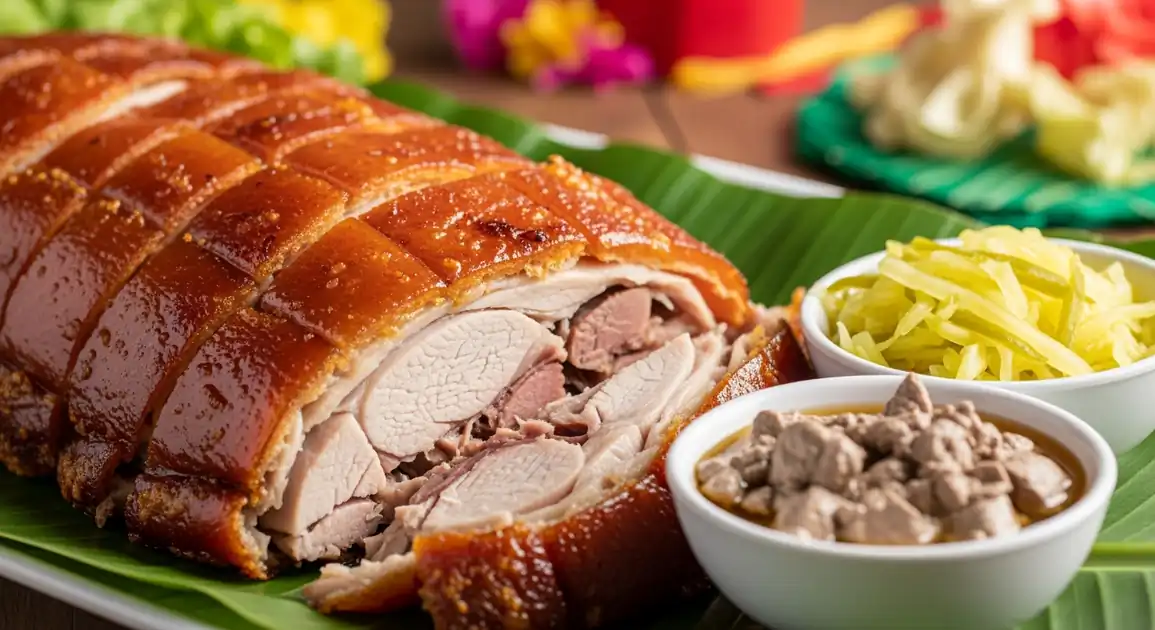Lechon (Roasted Pig)
Lechon Baboy / Litson

Description
Manila offers numerous Lechon options, primarily adhering to the Luzon style which emphasizes pairing with a rich liver sauce. Famous Lechon houses like Elar's, Lydia's, and Ping Ping's originated here. You can buy Lechon by weight or order whole pigs from these established vendors and numerous smaller players.
Dietary Information
Serving information
Serving style
Served by weight or as part of restaurant meals. Liver sauce ('sarsa') is almost always provided and expected.
Quick facts
Dedicated stores: 10 AM - 8 PM typically. Market stalls: Earlier hours, may sell out by afternoon.
Safety Tips
What to Look For
-
Incredibly crispy, crackling skin
This is the primary indicator of freshly roasted, high-quality Lechon. Soggy skin means it's old or improperly stored.
-
Moist, juicy-looking meat
The meat should not appear dry or tough. Look for visible succulence when carved.
-
Vendor carves from a whole pig upon ordering
Ensures greater freshness compared to pre-carved portions sitting out.
-
High customer turnover
Busy stalls sell Lechon quickly, ensuring the product doesn't sit for too long.
-
Clean serving area and utensils
Basic food hygiene is crucial. Check for clean chopping boards, knives, and serving practices.
What to avoid
-
Soggy, rubbery, or soft skin
Indicates the Lechon is old or has been stored improperly, losing its essential crispiness.
-
Dry, stringy-looking meat
Suggests overcooking or that the Lechon has been sitting for too long.
-
Pre-carved portions sitting uncovered at room temperature for extended periods
Increases risk of bacterial contamination, especially in warm climates.
-
Visible flies or pests around the food
Major hygiene red flag.
-
Vendor handles money then food without washing hands/changing gloves
Risk of cross-contamination.
Price information
Price range
Budget tips
- Prices per kilo are relatively standard among major players.
- Market stalls might offer slightly lower prices.
- Ordering whole pigs often has tiered pricing based on size.
Value indicators
- Crispy skin, moist meat.
- Quality and flavor of the liver sauce are crucial for Manila style.
- Reputation of the vendor (Elar's, Lydia's known for decades).
Where to Find This Dish
Quezon City (La Loma)
Historically known as the 'Lechon Capital' of Manila, home to many original vendors like Elar's, Ping Ping's, Monchie's.
La Loma neighborhood
Daytime
Restaurant Chains
Branches of Lydia's Lechon, Andok's (also known for chicken), Baliwag Lechon Manok & Liempo are widespread.
Malls, Commercial areas
Mall hours
Public Markets
Markets like Farmer's Market (Cubao), Seaside Market (Pasay) often have Lechon stalls.
Major public markets
Morning, Lunch
Vendor Tips
- Specify the amount clearly (e.g., 'kalahating kilo' - half kilo).
- Ask for extra sauce ('dagdag sarsa po') if needed.
- La Loma offers a concentration of traditional vendors to compare.
- Call ahead for whole pig orders, especially during holidays.
How to Order
Regional Variations
-
Specific Liver Sauces
(Sarsa ng Lechon)
Different vendors pride themselves on their specific 'sarsa' recipe, which can vary in sweetness, tanginess, and thickness.
-
Lechon Macau
(Lechon Macau / Bagnet)
While different, sometimes found alongside Lechon Baboy. It's deep-fried pork belly (similar to Lechon Kawali), originating from Ilocos but popular in Manila.
Cultural context
History
Roasting pigs predates Spanish colonization, but the specific 'Lechon' tradition as known today, including the name, has significant Spanish influence, merging indigenous roasting techniques with European fiesta culture. It became deeply ingrained as a symbol of hospitality, celebration, and community gathering throughout the archipelago, evolving regional variations like the distinct Cebu and Manila styles.
Local significance
A cornerstone of Manila celebrations and feasts. The liver sauce pairing is central to the Manila Lechon identity.
Eating customs
- Generously spooning liver sauce over the meat and rice.
- Ensuring everyone gets a piece of the coveted crispy skin.